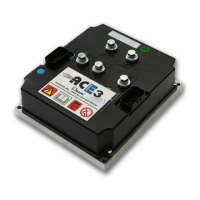Page – 30/139 AFFZP0BB – ACE3 – User Manual
6.2 Hardware installation
U Before doing any operation, ensure that the battery is disconnected and when
the installation is completed start the machine with the drive wheels raised
from the ground to ensure that any installation error do not compromise
safety.
U After the inverter turn-off, even with the key switch open, the internal
capacitors may remain charged for some time. For safe operation onto the
setup, it is recommended to disconnect the battery and to discharge the
capacitors by means of a resistor of about 10 – 100 Ohm between the +Batt
and -Batt terminals of the inverter.
6.2.1 Positioning and cooling of the controller
Install the inverter with the base-plate on a flat metallic surface.
- Ensure that the installation surface is clean and unpainted.
- Apply a thin layer of thermo-conductive grease between the two surfaces to
allow better heat dissipation.
- Ensure that cable terminals and connectors are correctly connected.
- Fit transient suppression devices to the horn, solenoids and contactors not
connected to the controller.
- Ensure the compartment to be ventilated and the heat-sinking materials ample.
- The heat-sinking material and should be sized on the performance requirement
of the machine. Abnormal ambient temperatures should be considered. In
situations where either external ventilation is poor or heat exchange is difficult,
forced ventilation should be used.
- The thermal energy dissipated by the power module varies with the current
drawn and with the duty cycle.
6.2.2 Wirings: power cables
- Power cables must be as short as possible to minimize power losses.
- They must be tightened onto the controller power posts with a torque in the 13
Nm – 15 Nm range.
- The ACE3 module should only be connected to a traction battery. Do not use
converters outputs or power supplies. For special applications please contact
the nearest Zapi Service Centre.
U Do not connect the controller to a battery with a nominal voltage different to
the nominal value, indicated on the controller label. A higher battery voltage
may cause failures in the power section. A lower voltage may not allow the
controller to work.

